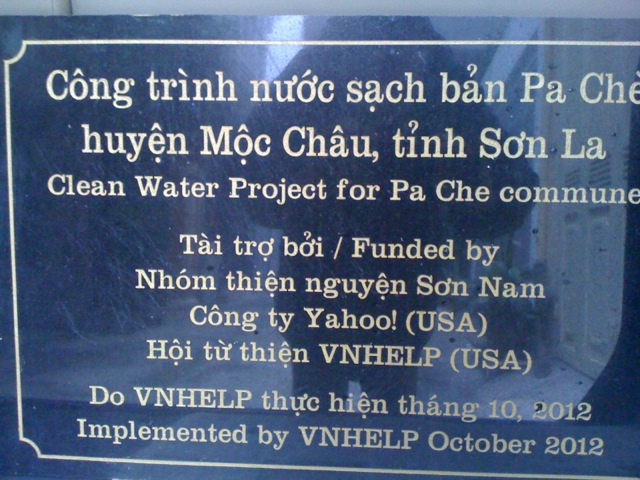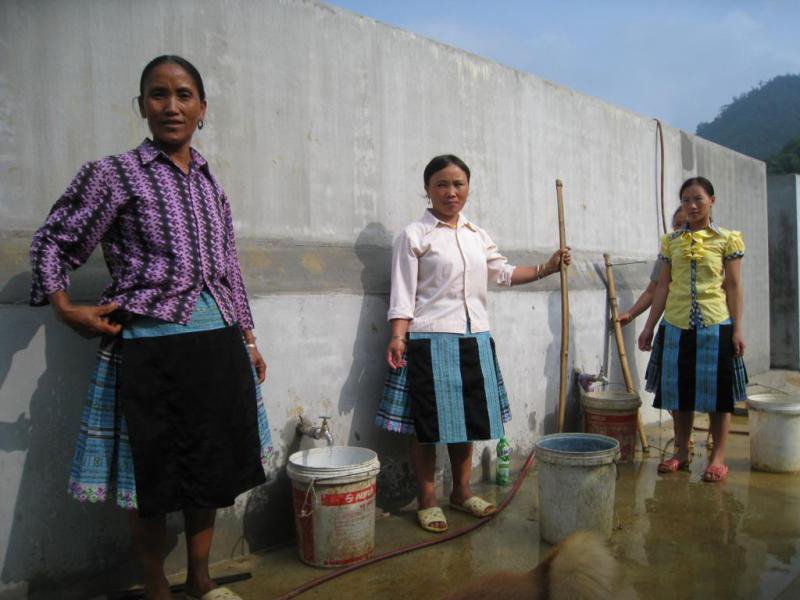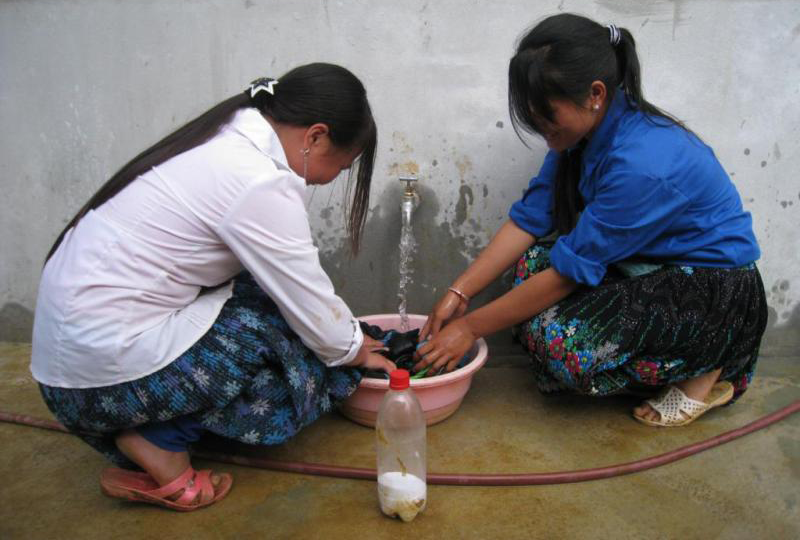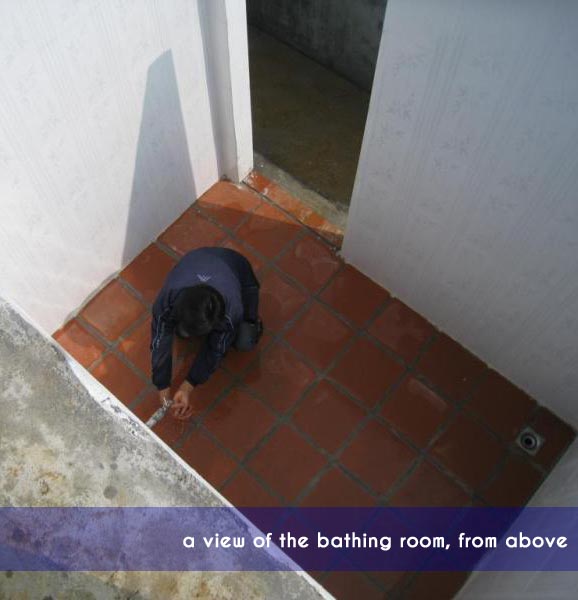Read the Vietnamese version of this post here.
Hop Duc Bui, a retired engineer now residing in San Jose, CA, recently co-funded a water project in Pa Che with his colleagues at the Son Nam Charitable Group and the Yahoo! Employee Foundation. He compiled this story based on project reports from Vietnam and shares it with you.
It had been a long time since we lasted visited our friends in Pa Che and shared with them a cup of corn wine, the local delicacy there. We often joke that “Pa Che” should actually be called “Ba Chen,”¹ because if you don’t drink at least 3 cups, the village elders won’t let you leave. This time, we wanted to see how the clean water project was going for the villagers.
***
The car sped along Highway 6 in a putt-putt motion. From Hanoi to Moc Chau, it’s about 199 kilometers. Beyond the car windows, herds of sheep grazed lazily on rolling green plains as deep as the steppes of Mongolia. A clear blue sky hung overhead, and the weather humored us with a temperate 20° C, redolent of the healing climates of Da Lat². Once we reached Moc Chau, the car turned into Pa Che’s scrappy village road, about 20 kilometers long. Too entranced by the surrounding scenery, we didn’t even notice when the car came to a stop and pulled into the project site.
We observed the scene that followed in quiet amusement. The village’s elderly Hmong women, in their colorful traditional garb, cooed softly in song while tending to their washing needs by the cistern. From the bathing house, the sounds of water lapping softly over cleansed skin floated out of the windows.
Ever since the water system was installed, the villagers have found new contentment, no longer needing to venture far to haul back muddy stream water. The water tank was erected next to the newly-constructed Van Ho Elementary School in Son La province’s Moc Chau district. From a distance, one can see a green mountain range with white clouds dancing on the peaks, as alluring as the Mt. Hamilton range in California.³
Inquiring about how clean water was being brought to the village, the purpose of our visit, we saw that the project this time included:
- Constructing a water tank, 5 m x 5.2 m x 2.2 m in volume
- Paving two cleaning platforms affixed to the front and rear of the tank, each platform measuring 5 m x 1.6 m
- Erecting 4 bathing rooms on the sides of the tank, each room measuring 1.6 m x 2.4m x 2.2m in volume
- Installing a water pump with a pumping capacity of 10 cubic meters an hour
- Installing a piping system
- Maintaining a pre-drilled well, a remnant of the Vietnam War
The project cost a little more than $16,000, with my Son Nam Charitable Association providing $5,000, the Yahoo! Employee Foundation providing $5,000, and VNHELP providing the remaining funds.

While inspecting the project, we noticed that the bathing rooms didn’t have a roof over them, and inquired about this to the project manager.
“Bathing rooms without roofs are typical of Hmong traditions,” he explained. “These traditions have been observed since the times of French occupation.”
At the same time, he also reported, “The construction of the water tank began on October 15, 2012 and was done by October 30, 2012. It was designed by Alcovina Co. and constructed by Tam An Constructions.”
He then explained the complicated process it took to get the water quality evaluated:
The People’s Committee at the village had tested the water quality and determined that ‘the water does not need to be treated with chemicals.’ We sent this report to the VNHELP Consulting Team, but they informed us, ‘This report has no technical guarantee, nor does it have any binding legal value, because the People’s Committee does not have jurisdiction to monitor such things.’ We then sent water samples to the Sanitation and Water Authorities in Ha Noi. After examining the inspection report dated November 21, the Consulting Team gave us some official recommendations on water usage.
Once we’d learned all we had come to learn, the inspection was done. We said our goodbyes and were about to leave to make our car ride back, but stopped once again when we heard singing rising from the male bathing house:
| Xin đẽo cây cho em cắt bằng Anh hát trước em đáp sau Then sẽ cho ta thành bạn |
I’ll hewn the branch so you can whittle it even I’ll sing first and you respond Fate will make us friends |
And from the women’s bathing house in response:
| Mường em không nhiều cái lạ Mường em có lắm cái hay Anh chặt cây em xin kéo Anh đẽo cây em xin cắt bằng Anh hát em xin đáp lời Then cho ta thành đôi Then cho ta thành bạn… |
Nothing unusual in my village Many wonders in my village You cut the tree and let me pull it You hewn the tree and I’ll whittle it even You sing and I’ll respond Fate will make us a pair Fate will make us friends… |
***
Whenever we return to Vietnam, we witness many regions that suffer illness because the whole village bathed, laundered, and drank from a murky pond. That is the impetus for VNHELP, our Sơn Nam Charitable group, and others to implement many clean water projects for our less fortunate friends. Now, at many locations, free clean water runs straight to households via a valve and pipe system. Thank you to VNHELP for gathering the resources and implementing these much needed projects.
Even though I know our work and the work of our friends can’t change everything about the lives of others, we feel grateful and blessed each time we can give anyone a ladder out of the malaise of poverty.
¹”Ba Chen,” which has a similar pronounciation to “Pa Che” in Vietnamese, literally means “3 cups.”
²Da Lat is a city in Central Vietnam. It is well-known for its natural scenery and year-round cool weather.
³The Mt. Hamilton range is the tallest mountain in Silicon Valley. Here is an image.
Tags: clean water






